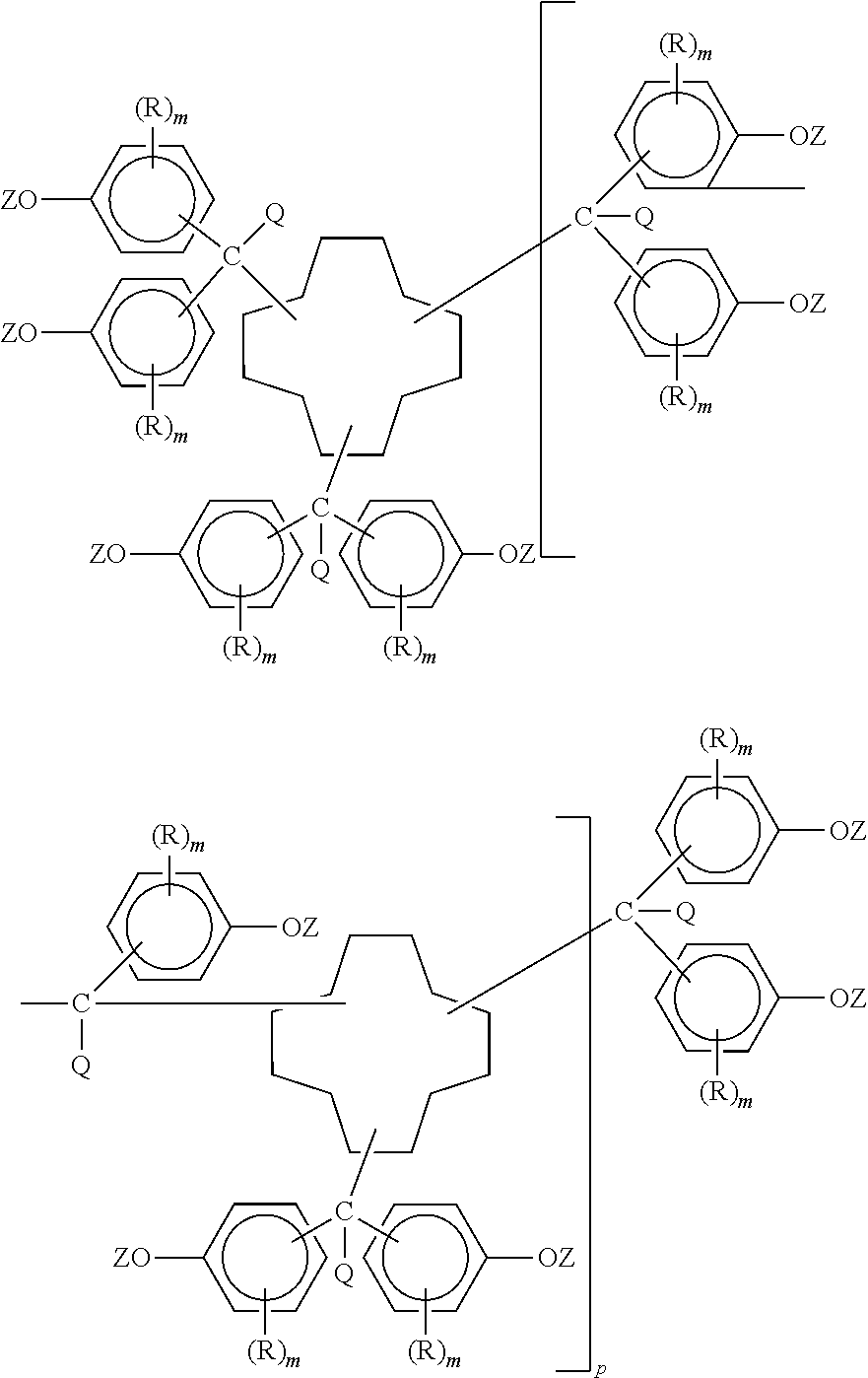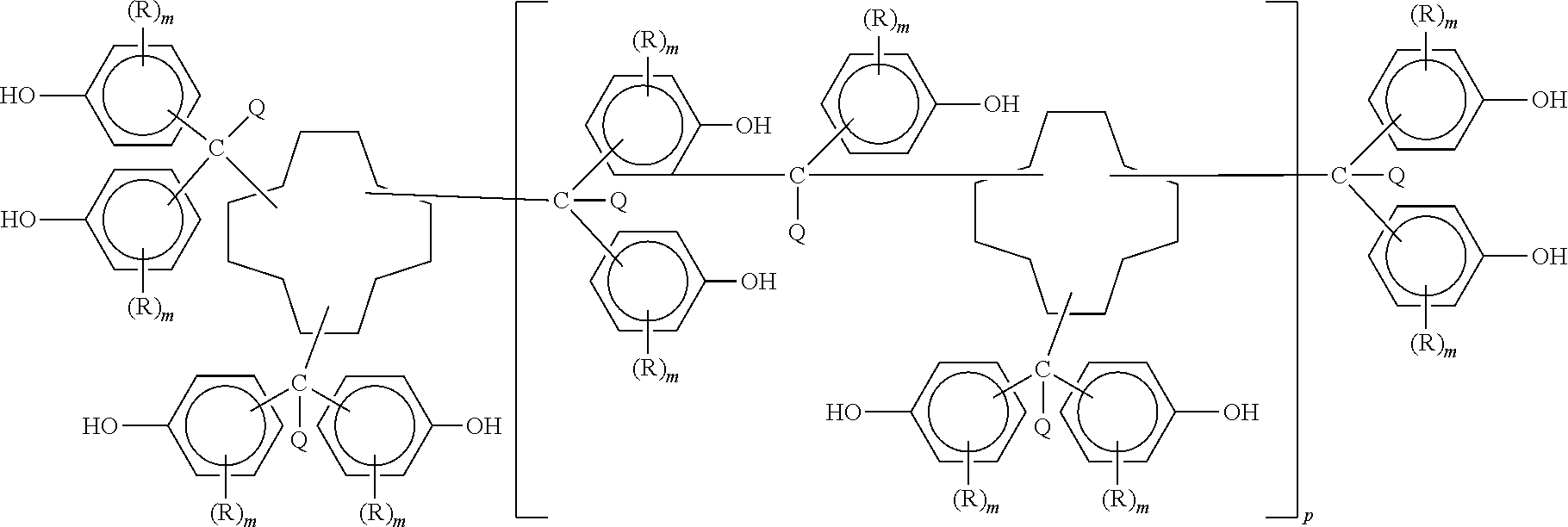Polycyanates of cyclododecane polyphenols and thermosets thereof
a technology of cyclododecane polyphenols and polycyanates, which is applied in the field of cyanate resins, can solve the problems of cracking or delamination, excessive enthalpic cure energy, and difficulty in using such monomers, and achieves improved cure profiles, increased thermal stability, and improved tg
- Summary
- Abstract
- Description
- Claims
- Application Information
AI Technical Summary
Benefits of technology
Problems solved by technology
Method used
Image
Examples
reference example 1
Synthesis of Polyphenol of Cyclododecane Trialdehyde
[0038]CDD trialdehyde obtained from the hydroformylation of cyclododecatriene was analyzed by gas chromatography demonstrating the following composition: cyclododecatriene (0.15 wt. %), CDD monoaldehyde (0.16 wt. %), CDD dialdehyde (9.52 wt. %) and CDD trialdehyde (88.72 wt. %). Reaction of CDD trialdehyde (39.74 g, 0.16 mole, 0.48 aldehyde eq) and molten phenol (301.2 g, 3.2 moles) using 3-mercapto-1-propane sulfonic acid catalyst (total catalyst used was 1.25 g, 0.05 mole % with respect to CDD trialdehyde reactant) provided the polyphenol of CDD trialdehyde as a reddish tan colored powder (107.00 g). HPLC analysis of a sample of the product demonstrated the presence of 1.89 area % residual phenol. FTIR spectrophotometric analysis of a KBr pellet revealed complete disappearance of the aldehyde carbonyl stretch at 1721.9 cm−1 with appearance of strong aromatic ring absorbance at 1610.8 (shoulder at 1595.5) and 1510.2 cm−1, broad st...
example 1
Synthesis of Polycyanate of the Polyphenol of Cyclododecane Trialdehyde (Containing Residual Unreacted Hydroxyl)
[0039]A 500 milliliter, three neck, glass, round bottom reactor was charged with 2.56 grams of polyphenol of cyclododecane trialdehyde (nominally 0.02 hydroxyl equivalent) from Reference Example 1, anhydrous dichloromethane (250 milliliters) and anhydrous acetone (75 milliliters). The reactor was additionally equipped with a condenser (maintained at 0° C.), a thermometer, an overhead nitrogen inlet (1 liter per minute used), a septum covered port, and magnetic stirring. Stirring commenced at to room temperature (22° C.) to provide a solution followed by placement of a dry ice-acetone bath for cooling under the reactor. The stirred solution was cooled to 8° C. then cyanogen bromide (2.23 grams, 0.02105 mole, 1.05:1 cyanogen bromide:nominal hydroxyl equivalent ratio) was added to the solution and dissolved therein. The solution was further cooled to −8° C. while being stirre...
example 2
Synthesis of the Homopolytriazine of Polycyanate of the Polyphenol of Cyclododecane Trialdehyde (Containing Residual Unreacted Hydroxyl)
[0041]Differential scanning calorimetry (DSC) analysis of a portion (8.6 milligrams) of polycyanate of the polyphenol of cyclododecane trialdehyde from Example 1 was completed using a rate of heating of 7° C. per minute from 25° C. to 400° C. under a stream of nitrogen flowing at 35 cubic centimeters per minute. A DSC 2910 Modulated DSC (TA Instruments) was used for the analysis. No melt endotherm was detected. A sharp exotherm attributed to cyclotrimerization was detected with a 120.3° C. onset, a 212.3° C. midpoint, and a 247.4° C. end accompanied by an enthalpy of 166.7 joules per gram. This was followed by a second broad exotherm with a 253.5° C. onset, a 324.5° C. midpoint, and a 380.5° C. end accompanied by an enthalpy of 59.2 joules per gram.
PUM
| Property | Measurement | Unit |
|---|---|---|
| reaction temperature | aaaaa | aaaaa |
| Tg | aaaaa | aaaaa |
| Tg | aaaaa | aaaaa |
Abstract
Description
Claims
Application Information
 Login to View More
Login to View More - R&D
- Intellectual Property
- Life Sciences
- Materials
- Tech Scout
- Unparalleled Data Quality
- Higher Quality Content
- 60% Fewer Hallucinations
Browse by: Latest US Patents, China's latest patents, Technical Efficacy Thesaurus, Application Domain, Technology Topic, Popular Technical Reports.
© 2025 PatSnap. All rights reserved.Legal|Privacy policy|Modern Slavery Act Transparency Statement|Sitemap|About US| Contact US: help@patsnap.com



